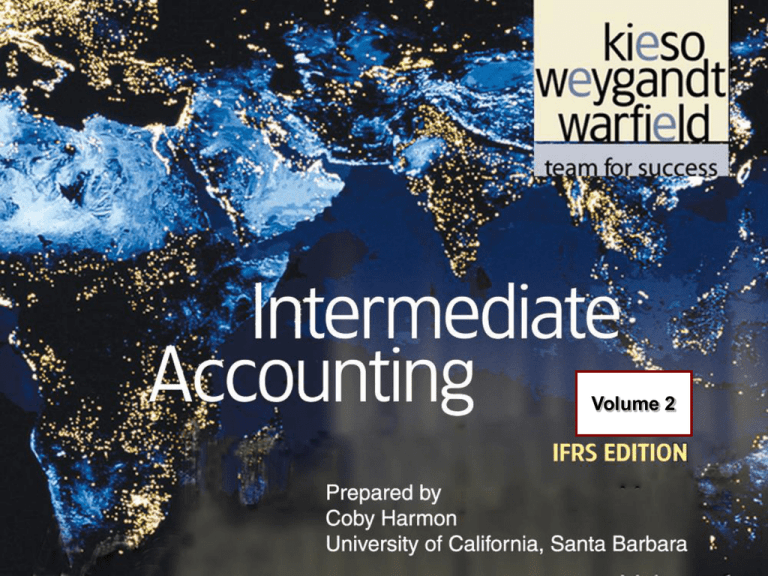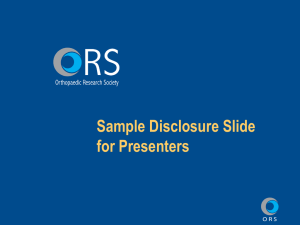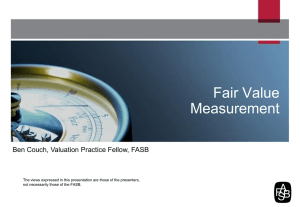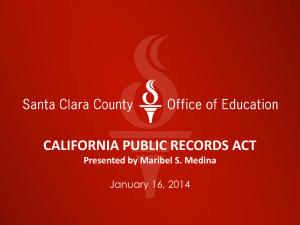
Volume 2
24-1
CHAPTER
24
PRESENTATION AND DISCLOSURE IN
FINANCIAL REPORTING
Intermediate Accounting
IFRS Edition
Kieso, Weygandt, and Warfield
24-2
Learning Objectives
1.
Review the full disclosure principle and describe implementation
problems.
2.
Explain the use of notes in financial statement preparation.
3.
Discuss the disclosure requirements for major business segments.
4.
Describe the accounting problems associated with interim reporting.
5.
Identify the major disclosures in the auditor’s report.
6.
Understand management’s responsibilities for financials.
7.
Identify issues related to financial forecasts and projections.
8.
Describe the profession’s response to fraudulent financial reporting.
24-3
Full Disclosure in Financial Reporting
Full Disclosure
Principle
Increase in
reporting
requirements
Differential
disclosure
Notes to
Financial
Statements
Accounting
policies
Common
notes
Disclosure
Issues
Special
transactions
or events
Events after
the reporting
period
Diversified
companies
Interim
reports
24-4
Auditor’s and
Management’s
Report
Auditor’s
report
Management’s
reports
Current
Reporting
Issues
Reporting on
forecasts and
projections
Internet financial
reporting
Fraudulent
financial
reporting
Criteria for
accounting and
reporting
choices
Full Disclosure Principle
Full disclosure principle calls for financial reporting of any
financial facts significant enough to influence the judgment
of an informed reader.
Financial disasters at Parmalat (ITA), Mahindra Satyam
(IND), Société Générale (FRA), and AIG (USA) highlight
the difficulty of implementing the full disclosure principle.
24-5
LO 1 Review the full disclosure principle and describe implementation problems.
Full Disclosure Principle
Illustration 24-1
Types of Financial
Information
24-6
LO 1 Review the full disclosure principle and describe implementation problems.
Full Disclosure Principle
Increase in Reporting Requirements
Reasons:
24-7
Complexity of business environment.
Necessity for timely information.
Accounting as a control and
monitoring device.
LO 1 Review the full disclosure principle and describe implementation problems.
Full Disclosure Principle
Differential Disclosure
IASB has developed IFRS for small- and medium-sized entities
(SMEs). SMEs are entities that
24-8
Publish general purpose financial statements for external
users.
Do not issue shares or other securities in a public market.
Single standard of fewer than 230 pages.
Designed to meet the needs and capabilities of SMEs, which
are estimated to account for over 95 percent of all companies
around the world.
LO 1 Review the full disclosure principle and describe implementation problems.
Notes to the Financial Statements
Notes are the means of amplifying or explaining the items
presented in the main body of the statements.
Accounting Policies
Companies should present a statement identifying the accounting
policies adopted (Summary of Significant Accounting Policies).
In addition, companies must:
24-9
1.
Identify judgments made in the process of applying the
accounting policies.
2.
Disclose information about assumptions made.
LO 2 Explain the use of notes in financial statement preparation.
Notes to the Financial Statements
Which of the following should be disclosed in a Summary of
Significant Accounting Policies?
a. Types of executory contracts.
b. Amount for cumulative effect of change in accounting
principle.
c. Claims of equity holders.
d. Depreciation method followed.
24-10
LO 2 Explain the use of notes in financial statement preparation.
Notes to the Financial Statements
Common Notes
24-11
Inventory
Property, Plant, and Equipment
Creditor Claims
Equity Holders’ Claims
Contingencies and Commitments
Fair Values
Deferred Taxes, Pensions, and Leases
Changes in Accounting Principles
LO 2 Explain the use of notes in financial statement preparation.
Disclosure Issues
Disclosure of Special Transactions or Events
24-12
Related-party transactions
►
Nature of relationship.
►
Amount of transaction and outstanding balances.
►
Provision for doubtful debts.
►
Expense recognized during the period in respect of
bad or doubtful debts due from related parties.
Errors and fraud.
LO 2 Explain the use of notes in financial statement preparation.
Disclosure Issues
If a business entity entered into certain related party transactions, it
would be required to disclose all the following information except the
a. nature of the relationship between the parties to the
transactions.
b. nature of any future transactions planned between the parties
and the terms involved.
c. dollar amount of the transactions for each of the periods for
which an income statement is presented.
d. amounts due from or to related parties as of the date of each
statement of financial position presented.
24-13
LO 2 Explain the use of notes in financial statement preparation.
Disclosure Issues
Events after the Reporting Period
(Subsequent Events)
1 - Events that provide additional
evidence about conditions that
existed at the statement of financial
position date.
24-14
Illustration 24-5
Time Periods for
Subsequent Events
2 - Events that provide
evidence about conditions that
did not exist at the statement of
financial position date.
LO 2 Explain the use of notes in financial statement preparation.
Disclosure Issues
E24-2 (Post-Balance-Sheet Events): For each of the following
subsequent events, indicate whether a company should (a) adjust the
financial statements, (b) disclose in notes to the financial statements, or
(c) neither adjust nor disclose.
a 1.
______
Settlement of tax case at a cost considerably in excess of
the amount expected at year-end.
______
c 2.
Introduction of a new product line.
______
b 3.
Loss of assembly plant due to fire.
______
b 4.
Sale of a significant portion of the company’s assets.
______
c 5.
Retirement of the company president.
______
b 6.
Issuance of a significant number of ordinary shares.
24-15
LO 2 Explain the use of notes in financial statement preparation.
Disclosure Issues
E24-2 (Post-Balance-Sheet Events): For each of the following
subsequent events, indicate whether a company should (a) adjust the
financial statements, (b) disclose in notes to the financial statements, or
(c) neither adjust nor disclose.
______
c 7.
Loss of a significant customer.
c 8.
______
Prolonged employee strike.
______
a 9.
Material loss on a year-end receivable because of a
customer’s bankruptcy.
______
c 10. Hiring of a new president.
______
a 11. Settlement of prior year’s litigation.
______
b 12. Merger with another company of comparable size.
24-16
LO 2 Explain the use of notes in financial statement preparation.
Disclosure Issues
Reporting for Diversified Companies
Investors and investment analysts income statement, statement
of financial position, and cash flow information on the individual
segments that compose the total income figure.
Illustration 24-7
Segmented Income
Statement
24-17
LO 3
Disclosure Issues
Objective of Reporting Segmented Information
To provide information about the different types of business
activities in which an enterprise engages and the different
economic environments in which it operates.
Meeting this objective will help users:
a) Better understand the enterprise’s performance.
b) Better assess its prospects for future net cash flows.
c) Make more informed judgments about the enterprise as a
whole.
24-18
LO 3 Discuss the disclosure requirements for major business segments.
Disclosure Issues
Basic Principles
IFRS requires that general-purpose financial statements
include selected information on a single basis of segmentation.
A company can meet the segmented reporting objective by
providing financial statements segmented based on how the
company’s operations are managed (management
approach).
24-19
LO 3 Discuss the disclosure requirements for major business segments.
Disclosure Issues
Identifying Operating Segments
An operating segment is a component of an enterprise:
a. That engages in business activities from which it earns
revenues and incurs expenses.
b. Whose operating results are regularly reviewed by the
company’s chief operating decision maker.
c. For which discrete financial information is available.
24-20
LO 3 Discuss the disclosure requirements for major business segments.
Disclosure Issues
Identifying Operating Segments
Quantitative Materiality Test: Must satisfy one to determine
whether the segment is significant enough to warrant actual disclosure.
1.
Its revenue is 10 percent or more of the combined revenue of all the
company’s operating segments.
2.
The absolute amount of its profit or loss is 10 percent or more of the
greater, in absolute amount, of (a) the combined operating profit of all
operating segments that did not incur a loss, or (b) the combined loss of
all operating segments that did report a loss.
3.
Its identifiable assets are 10 percent or more of the combined assets
of all operating segments.
24-21
LO 3
Disclosure Issues
Identifying Operating Segments
Quantitative Materiality Test: In applying these tests, the company
must consider two additional factors.
24-22
1.
Segment data must explain a significant portion of the company’s
business. Specifically, the segmented results must equal or exceed 75
percent of the combined sales to unaffiliated customers for the entire
company.
2.
The IASB decided that 10 is a reasonable upper limit for the number of
segments that a company must disclose.
LO 3 Discuss the disclosure requirements for major business segments.
LO 3
Disclosure Issues
Materiality Test Illustration
Illustration 24-8
Data for Different Possible
Reporting Segments
Reporting segments are therefore A, C, D, and E, assuming that these four
segments have enough sales to meet the 75 percent of combined sales test.
24-23
LO 3
Disclosure Issues
Materiality Test Illustration
24-24
Illustration 24-8
Data for Different Possible
Reporting Segments
LO 3 Discuss the disclosure requirements for major business segments.
LO 3
Disclosure Issues
Segmented Information Reported
1. General information about operating segments.
2. Segment profit and loss and related information.
3. Segment assets and liabilities.
4. Reconciliations.
5. Information about products and services and geographic
areas.
6. Major customers.
24-25
LO 3 Discuss the disclosure requirements for major business segments.
Disclosure Issues
Revenue of a segment includes
a. only sales to unaffiliated customers.
b. sales to unaffiliated customers and intersegment
sales.
c. sales to unaffiliated customers and interest
revenue.
d. sales to unaffiliated customers and other revenue
and gains.
24-26
LO 3 Discuss the disclosure requirements for major business segments.
Disclosure Issues
The profession requires disaggregated information in the
following ways:
a. products or services.
b. geographic areas.
c. major customers.
d. all of these.
24-27
LO 3 Discuss the disclosure requirements for major business segments.
Disclosure Issues
Interim Reports
Cover periods of less than one year.
Two viewpoints exist:
1. Discrete approach
2. Integral approach
Companies should use the same accounting principles for
interim reports that they use for annual reports.
24-28
LO 4 Describe the accounting problems associated with interim reporting.
Disclosure Issues
Unique Problems of Interim Reporting
(1) Income taxes
(2) Seasonality
(3) Continuing controversy - debate on the independent
auditor’s involvement in interim reports.
24-29
LO 4 Describe the accounting problems associated with interim reporting.
Disclosure Issues
In considering interim financial reporting, how does the
profession conclude that such reporting should be viewed?
a. As a "special" type of reporting that need not follow
generally accepted accounting principles.
b. As useful only if activity is evenly spread throughout the
year so that estimates are unnecessary.
c. As reporting for a basic accounting period.
d. As reporting for an integral part of an annual period.
24-30
LO 4 Describe the accounting problems associated with interim reporting.
Auditor’s and Management’s Reports
Auditor’s Report
Illustration 24-14
Auditor’s Report
Unmodified Opinion –
auditor expresses the
opinion that the financial
statements are presented
fairly in accordance with
IFRS. Other opinions:
24-31
Qualified
Adverse
Disclaim
LO 5 Identify the major disclosures in the auditor’s report.
Auditor’s and Management’s Reports
Auditor’s Report
Certain circumstances, although they do not affect the
auditor’s unqualified opinion, may require the auditor to add
an explanatory paragraph to the audit report.
24-32
Going Concert
Lack of Consistency
Emphasis of a Matter
LO 5 Identify the major disclosures in the auditor’s report.
Auditor’s and Management’s Reports
Auditor’s Report
Qualified opinion contains an exception to the standard
opinion. Usual circumstances may include:
1. Scope limitation.
2. Statements do not fairly present financial position or
results of operations because of:
a. Lack of conformity with accepted standards.
b. Inadequate disclosure.
24-33
LO 5 Identify the major disclosures in the auditor’s report.
Auditor’s and Management’s Reports
Management’s Report
Management commentary helps in the interpretation of the
financial position, financial performance, and cash flows of a
company. Such a report may include a review of the:
24-34
Main factors and influences determining financial
performance;
Company’s sources of funding and its targeted ratio of
liabilities to equity; and
Company’s resources not recognized in the statement of
financial position in accordance with IFRS.
LO 5 Identify the major disclosures in the auditor’s report.
Auditor’s and Management’s Reports
Management’s Responsibilities for Financial
Statements
Management is responsible for preparing the financial statements
and establishing and maintaining an effective system of internal
controls.
The auditor provides an independent assessment of whether the
financial statements are prepared in accordance with IFRS, and
for public companies, whether the internal controls are effective
24-35
LO 6 Understand management’s responsibilities for financials.
Current Reporting Issues
Reporting on Financial Forecasts and
Projections
Financial forecast is a set of prospective financial statements
that present, a company’s expected financial position, results of
operations, and cash flows.
Financial projections are prospective financial statements
that present, given one or more hypothetical assumptions, an
entity’s expected financial position, results of operations, and
cash flows. Regulators have established a Safe Harbor Rule.
24-36
LO 7 Identify issues related to financial forecasts and projections.
Current Reporting Issues
Internet Financial Reporting
A large proportion of companies’ websites contain links to their
financial statements and other disclosures.
24-37
Allows firms to communicate more easily and quickly with
users.
Allow users to take advantage of tools such as search
engines.
Can help make financial reports more relevant by allowing
companies to report expanded disaggregated data.
LO 7 Identify issues related to financial forecasts and projections.
Current Reporting Issues
Fraudulent Financial Reporting
Intentional or reckless conduct, whether through act or omission,
that results in materially misleading financial statements.
Frauds involving such well-known companies as Parmalat (ITA),
Mahindra Satyam (IND), and Société Générale (FRA) indicate
that more must be done to address this issue.
24-38
LO 8 Describe the profession’s response to fraudulent financial reporting.
Current Reporting Issues
Fraudulent Financial Reporting
Causes of Fraudulent Financial Reporting
Common causes are the desire
►
to obtain a higher stock price,
►
to avoid default on a loan covenant, or
►
to make a personal gain of some type (additional
compensation, promotion).
24-39
LO 8 Describe the profession’s response to fraudulent financial reporting.
Current Reporting Issues
Fraudulent Financial Reporting
Causes of Fraudulent Financial Reporting
Common opportunities for fraudulent financial reporting
24-40
►
Absence of a board of directors or audit committee.
►
Weak or nonexistent internal accounting controls.
►
Unusual or complex transactions.
►
Accounting estimates requiring significant judgment.
►
Ineffective internal audit staffs.
LO 8 Describe the profession’s response to fraudulent financial reporting.
24-41
Due to the broader range of judgments allowed in more principle-based
IFRS, note disclosures generally are more expansive under IFRS
compared to U.S. GAAP.
U.S. GAAP and IFRS have similar standards on post-statement of
financial position (subsequent) events.
Subsequent events under IFRS are evaluated through the date that
financial instruments are “authorized for issue.” U.S. GAAP uses the
date when financial statements are “issued.” Also, for share dividends
and splits in the subsequent period, IFRS does not adjust but U.S.
GAAP does..
24-42
Like IFRS, U.S. GAAP requires that for transactions with related parties,
companies disclose the amounts involved in a transaction, the amount,
terms and nature of the outstanding balances, and any doubtful
amounts related to those outstanding balances for each major category
of related parties. There is no specific requirement to disclose the name
of the related party.
Following the recent issuance of IFRS 8, “Operating Segments,” the
requirements under IFRS and U.S. GAAP are very similar. That is, both
standards use the management approach to identify reportable
segments, and similar segment disclosures are required.
Perspective on Financial Statement Analysis
A logical approach to financial statement analysis is necessary,
consisting of the following steps.
1. Know the questions for which you want to find answers.
2. Know the questions that particular ratios and comparisons
are able to help answer.
3. Match 1 and 2 above. By such a matching, the statement
analysis will have a logical direction and purpose.
24-43
LO 9 Understand the approach to financial statement analysis.
Perspective on Financial Statement Analysis
Analysis includes an understanding that
1. Financial statements report on the past.
2. Single ratio by itself is not likely to be very useful.
3. Awareness of the limitations of accounting numbers used in
an analysis.
24-44
LO 9 Understand the approach to financial statement analysis.
Ratio Analysis
24-45
LO 10 Identify major analytic ratios and describe their calculation.
Ratio Analysis
24-46
Illustration 24A-1
LO 10 Identify major analytic ratios and describe their calculation.
Ratio Analysis
24-47
Illustration 24A-1
LO 10 Identify major analytic ratios and describe their calculation.
Ratio Analysis
24-48
Illustration 24A-1
LO 10 Identify major analytic ratios and describe their calculation.
Ratio Analysis
24-49
Illustration 24A-1
LO 10 Identify major analytic ratios and describe their calculation.
Limitations of Ratio Analysis
Based on historical cost.
Use of estimates.
Achieving comparability among firms in a given industry.
Substantial amount of important information is not
included in a company’s financial statements.
24-50
LO 11 Explain the limitations of ratio analysis.
Comparative Analysis
Illustration 24A-2
24-51
LO 12 Describe techniques of comparative analysis.
Percentage (Common Size) Analysis
Illustration 24A-3
24-52
LO 13 Describe techniques of percentage analysis.
Percentage (Common Size) Analysis
Illustration 24A-4
24-53
LO 13 Describe techniques of percentage analysis.
IFRS 1 requires that information in a company’s first IFRS
statements
1. be transparent,
2. provide a suitable starting point, and
3. Have a cost that does not exceed the benefits.
Overriding principle in converting from national GAAP to
IFRS (the conversion process) is full retrospective application
of all IFRS.
24-54
LO 14 Describe the guidelines for first-time adoption of IFRS.
General Guidelines
Objective is to present financial statements as if company always
reported on IFRS. To achieve this objective, a company must:
24-55
1.
Identify the timing for its first IFRS statements.
2.
Prepare an opening statement of financial position at the date of
transition to IFRS.
3.
Select accounting policies that comply with IFRS, and apply these
policies retrospectively.
4.
Consider whether to apply any optional exemptions and apply
mandatory exceptions.
5.
Make extensive disclosure to explain the transition to IFRS.
LO 14
Relevant Dates
Once a company decides to convert to IFRS, it must decide
on the following dates—transition date and reporting date.
Illustration 24B-1
First-Time Adoption
Timeline
24-56
LO 14
Implementation Steps
Opening IFRS Statement of Financial Position
Process involves the following steps:
1. Include all assets and liabilities that IFRS requires.
2. Exclude any assets and liabilities that IFRS does not
permit.
3. Classify all assets, liabilities, and equity in accordance with
IFRS.
4. Measure all assets and liabilities according to IFRS.
24-57
LO 15 Describe the implementation steps for preparing the
opening IFRS statement of financial position.
Exemptions from Retrospective Treatment
The Board identified three areas in which companies are
prohibited from retrospective application in first-time adoption
of IFRS:
1. Estimates.
2. Hedge accounting.
3. Non-controlling interests.
24-58
LO 16 Describe the exemptions to retrospective
application in first-time adoption of IFRS.
Exemptions from Retrospective Treatment
Illustration 24B-3
Elective Exemption from
Retrospective Treatment
24-59
LO 16 Describe the exemptions to retrospective
application in first-time adoption of IFRS.
Presentation and Disclosure
An entity’s first IFRS financial statements shall include:
24-60
three statements of financial position,
two statements of comprehensive income,
two separate income statements (if presented),
two statements of cash flows, and
two statements of changes in equity and related notes,
including comparative information.
LO 17 Describe the presentation and disclosure
requirements for first-time adoption of IFRS.
Presentation and Disclosure
A company’s first IFRS financial statements shall include
reconciliations of:
Its equity reported in accordance with previous GAAP to
its equity in accordance with IFRS at the transition date.
Its total comprehensive income in accordance with IFRS
to total comprehensive income in accordance with
previous GAAP for the same period.
24-61
LO 17 Describe the presentation and disclosure
requirements for first-time adoption of IFRS.
Copyright
Copyright © 2011 John Wiley & Sons, Inc. All rights reserved.
Reproduction or translation of this work beyond that permitted in
Section 117 of the 1976 United States Copyright Act without the
express written permission of the copyright owner is unlawful.
Request for further information should be addressed to the
Permissions Department, John Wiley & Sons, Inc. The purchaser
may make back-up copies for his/her own use only and not for
distribution or resale. The Publisher assumes no responsibility for
errors, omissions, or damages, caused by the use of these
programs or from the use of the information contained herein.
24-62






